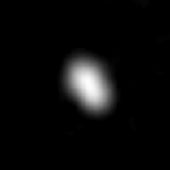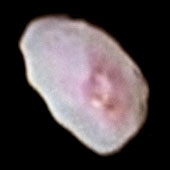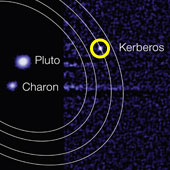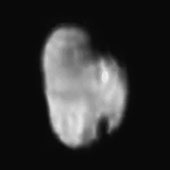The Plutonian system contains several smaller, irregular moons that we know very little about. These satellites are extremely small ans were not discovered until after 2005. Because of their small size, it is possible that some of these moons may be other Kuiper Belt objects that were captured by Pluto's gravity. These recent discoveries bring the total number of Plutonian moons to 5. Below is a listing of these moons in the order of their distance from Pluto. Images that appear on this page are the best available at this time. You may access information by clicking on the names below.
Styx | Nix | Kerberos | Hydra
Styx
Styx [stiks] is the innermost moon of Pluto. It is also the smallest of Pluto's five known moons. Since Pluto was named after the mythological god of the underworld, its moons have been named with the same theme. Styx was named after the mythical river that formed the boundary between Earth and the Underworld. Styx was discovered in 2012 by astronomer Mark R. Showalter using fourteen sets of images from the Hubble Space Telescope. Not much is known about this tiny moon other than the fact that is travels in a nearly circular orbit around Pluto.
|
Hubble image of Styx
(NASA/JHUAPL/SwRI) |
|
|
Statistics for Styx |
|
Discovered by
Year of Discovery
Approximate Diameter
Mean Distance from Pluto
Rotational Period
Orbital Period
Orbital Eccentricity
Orbital Inclination
Apparent Magnitude |
......
......
......
......
......
......
......
......
...... |
Mark R. Showalter et al.
2012
4.3 x 3.1 miles (7 x 5 km)
26,500 miles (42,656 km)
unknown
20.16 days
0
0.81 degrees
27 |
|
Nix
Nix [niks] is the second moon of Pluto. It was named after the Greek goddess of darkness and the night. She was also the mother of Charon, who was the ferryman of Hades. Nix was discovered by the Hubble Space Telescope Pluto Companion Search Team, composed of Hal A. Weaver, Alan Stern, Max J. Mutchler, Andrew J. Steffl, Marc W. Buie, William J. Merline, John R. Spencer, Eliot F. Young, and Leslie A. Young. Not much is known about Nix except that is has an irregular shape and is Pluto's third largest moon.
|
New Horizons image of Nix
(NASA/JHUAPL/SWRI) |
|
|
Statistics for Nix |
Discovered by
Year of Discovery
Approximate Diameter
Mean Distance from Pluto
Rotational Period
Orbital Period
Orbital Eccentricity
Orbital Inclination
Apparent Magnitude |
......
......
......
......
......
......
......
......
...... |
Hubble Space Telescope
2005
26 x 22 miles (42 x 36 km)
30,257 miles (48,694 km)
unknown
24.8 days
0.002
0.133 degrees
23.4 |
|
Kerberos
Kerberos [KUR-ber-uh s] is the third moon of Pluto. It was named after the mythical three-headed dog, or "hellhound" that guarded the entrance of the Greek underworld. Known also as Cerberus, this terrible creature had serpent's tail and a mane of snakes. Kerberos was discovered by Mark R. Showalter and the Pluto Companion Search Team using the Hubble Space Telescope. Not much is known about this tiny moon other than the fact that is travels in a nearly circular orbit around Pluto.
|
Hubble image of Kerberos
(NASA, ESA, and
L. Frattare (STScI)) |
|
|
Statistics for Kerberos |
|
Discovered by
Year of Discovery
Approximate Diameter
Mean Distance from Pluto
Rotational Period
Orbital Period
Orbital Eccentricity
Orbital Inclination
Apparent Magnitude |
......
......
......
......
......
......
......
......
...... |
Mark R. Showalter et al.
2011
19.2 miles (31 km)
35,905 miles (57,783 km)
unknown
32.16 days
0
0.389 degrees
26.1 |
|
Hydra
Hydra [HAHY-druh] is the fourth moon of Pluto. It was named after the nine-headed serpent that battled Hercules in Greek mythology. The nine heads of the Hydra are a reference to Pluto's tenure as the ninth planet of the Solar System. Hydra was discovered in 2005 by the Hubble Space Telescope's "Pluto Companion Search Team", consisting of Hal A. Weaver, Alan Stern, Max J. Mutchler, Andrew J. Steffl, Marc W. Buie, William J. Merline, John R. Spencer, Eliot F. Young, and Leslie A. Young. It is Pluto's second largest moon after Charon. Not much is known about this small moon other than the fact that it has an irregular shape and appears to have craters on its surface.
|
New Horizons image of Hydra
(NASA/JHUAPL/SWRI) |
|
|
Statistics for Hydra |
Discovered by
Year of Discovery
Approximate Diameter
Mean Distance from Pluto
Rotational Period
Orbital Period
Orbital Eccentricity
Orbital Inclination
Apparent Magnitude |
......
......
......
......
......
......
......
......
...... |
Hubble Space Telescope
2005
34 x 25 miles (55 x 40 km)
40,226 miles (64,738 km)
unknown
38.2 days
0.0
0.242 degrees
22.9
|
|







